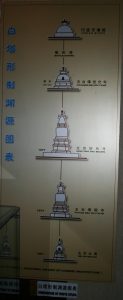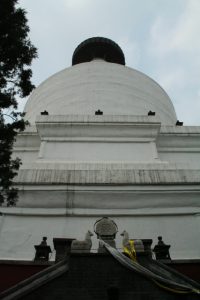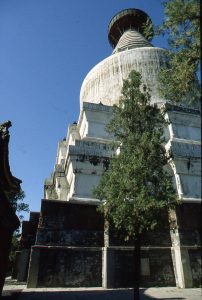Zanabazar, the first Jebtsundamba Khutukhtu (Jetsun Dampa Khutuktu)
Zanabazar (1635-1723) was the initial incarnation of the Urga or Jebtsundamba (rje btsun dam pa) lineage of the western Outer Mongolian (Khalkha) monastery Erdeni Zuu. Recognized by the Fifth Dalai Lama when he was twenty-five, Zanabazar later held a close relationship with the Kangxi emperor and is credited with convincing the Khalkha Mongols to submit to the Qing empire – and not to culturally alien Russia – around 1691.[[#_ftn1|[1]]] After this, Kangxi bestowed upon Zanabazar the title “Da Lama,” and in turn the lama alluded to their reenactment of Khubilai Khan and Phakpa’s close relationship during the Yuan dynasty. In addition to his spiritual and political roles, Zanabazar was renowned in his own time up to the present for the intricate and elegant sculpture he created in a Nepali-derived style.
In 1639, at the age of fifteen, Zanabazar (son of the Khalkha Tshuyetu Khan Gombodorji) was accepted as an incarnate lama by a convocation of Khalkha nobles at Erdeni Zuu. The Khalkha Khan may have been trying to usurp some of the power of the Gelugpa (dge lugs pa) sect, and at the same time circumvent a potential alliance between the Tibetans and the newly founded Qing dynasty. The boy was sent to Tibet for recognition by the Dalai Lama in 1649, and he received many initiations and teachings over the next year from the Great Fifth and from the Fourth Panchen Lama Lobsang Chokyi Gyaltsen (blo bzang chos skyid rgyal mtshan). The Dalai Lama also gave Zanabazar the title Jebtsundamba Khutukhtu and recognized him as the reincarnation of Taranatha (1575-1634), a Jonangpa (jo nang pa) missionary lama who had traveled widely in Inner Mongolia and rivaled Gelugpa influence in the region. This recognition had astute political consequences. Besides transferring all the merit accumulated by Taranatha in Tibet and Mongolia to Zanabazar (and the Gelugpa), the Fifth Dalai Lama was also able to incorporate Taranatha’s monastery in Tibet, the center of the Jonangpa, Puntsokling (phun tshogs gling). The Great Fifth then “renovated” this monastery with murals by Nepali artists, thus materially inscribing there his ambition. Zanabazar did not preside over Puntsokling, however, but returned instead to Khalkha in the company of fifty painters and bronze casters (commanding both Nepali and Tibetan styles) to build a stupa for Taranatha’s remains, and to establish a new Gelugpa stronghold at Erdeni Zuu.
Zanabazar also never took up permanent residence at his seat of Erdeni Zuu, however, which was the largest stationary monastery of its time. His real establishment was in fact a traveling one; called orgoo (or in Russian, Urga) or Da Khuree or Ikh Khuree, which in Mongolian means Great Circle. With his traveling entourage, Zanabazar worked to carry out the proselytizing mission of the Gelugpas, especially the Fifth Dalai Lama. On the other hand, the Dalai Lama and Jetsundamba Khutukhtu sometimes acted like rival lords, investing, entitling, and providing seals for Mongol Khans, arbitrating disputes between the Khans, and – like emperors and Khans – receiving and dispatching embassies and commanding populations and sometimes even armies. Zanabazar’s Da Khuree ranged over at least seventeen different locations and five hundred kilometers between the mid-seventeenth and eighteenth century. The decoration of the lama’s roving temples reveals some of the techniques he employed towards his proselytizing and diplomatic ends, through his deep engagement with the elaborate artistic traditions and ritualism of his day. His tents were rich with painting, sculpture, textile hangings, and ritual objects created in his workshop. Zanabazar is also said to have composed ceremonial music and designed monks’ costumes and rituals, based on what he had seen at the Panchen Lama’s monastery Tashilunpo (bkra shis lhun po). His famous Nepali-influenced bronze sculptures are said to have been “created” at the unlikely place of Tovghuun, his retreat center on the outskirts of Erdeni Zuu. Patricia Berger argues that this reference mostly likely means that Zanabazar visualized the sculptures during meditation retreat after receiving various spiritual transmissions of texts (he was especially associated with Tara and Vajrapani), and that their later execution took place with the help of his artisan entourage. Actual production sites were spread over a wide geographic swath, unsurprisingly also linking sites of Zanabazar’s diplomatic and missionary endeavors: Beijing, Chengde, Dolonnor, Inner Mongolian Koke qota, and Amdo. Bronzes were sent to the court of the Kangxi emperor around 1655, and Zanabazar is also said to have produced sculptures in metal and gemstones while visiting Beijing in 1691. Continuing the tradition of Nepali-style artistry at the imperial court begun by Anige during the Yuan period, Zanabazar’s bronzes profoundly influenced Qing art.
Zanabazar’s visit to Beijing in 1691 came at a politically significant moment. The lama had just convinced the Khalkhas to submit to the Qing empire at Dolonnor, siding with the Kangxi emperor against the Western Mongolian Dzungars. Forging closer ties with the Manchu emperor – there is a story that Kangxi attempted to test the lama when he first arrived, but that Zanabazar revealed these tricks and also delighted the emperor with displays of his powers – Zanabazar again visited Beijing in 1721 to participate in Kangxi’s birthday celebrations. When the emperor passed away soon afterwards, Zanabazar came once more to conduct rituals for his death at Beijing’s Yellow Monastery (Huang si 黃寺). The lama passed away himself in Beijing only a few months later, in 1723. His body was sent back to Mongolia and mummified. Kangxi’s son, the Yongzheng emperor, ordered a Chinese-style monastery dedicated to Zanabazar’s main tutelary deity, Maitreya, to be built at the place where the lama’s traveling Da Khuree had stood at the moment of the his death. This monastery, called Amur-Bayasqulangtu or “Monastery of Blessed Peace,” resembles Yongzheng’s own palace Yonghegong in Beijing (converted by his son the Qianlong emperor into a Buddhist monastery). The monastery’s sophisticated construction in such a remote location – north of the modern city of Darkhan, near the northern Outer Mongolian border – demonstrates the far reach of the Qing empire in the early eighteenth century. Yongzheng pledged 100,000 liang of silver to the monastery’s construction, which was not completed until a year after his own death in 1736. Zanabazar’s body finally found its way there in 1779 (the project thus spanning three different reign periods), and remained at the monastery until being carried off and lost during the revolution in Mongolia of 1920s and 1930s.
Sources:
Patricia Berger. 2003. Empire of Emptiness: Buddhist Art and Political Authority in Qing China. University of Hawai’i Press.
Sabine Dabringhaus. 1997. “Chinese Emperors and Tibetan Monks: Religion as an Instrument of Rule,” in China and her neighbours. Wiesbaden: Harrasowitz Verlag.
James L. Hevia. 1995. “A multitude of lords: The Qing Empire, Manchu rulership and interdomainal relations,” in Cherishing men from afar: Qing guest ritual and the Macartney embassy of 1793. Durham N.C.: Duke University Press.
Wang Xiangyun. 2000. “The Qing court’s Tibet connection: Lcang skya Rol pa’I rdo rje and the Qianlong Emperor.” Harvard Journal of Asiatic Studies 60 (1): 125-163.
Entry by Stacey Van Vleet, 3/28/07
[[#_ftnref1|[1]]] The date of this event is contested; it is variously cited as 1688, 1691, or 1693.





